SPMI Interface: Advantages and Disadvantages
Advertisement
This page explores the pros and cons of the System Power Management Interface (SPMI) protocol. It highlights the benefits and drawbacks associated with using SPMI in various electronic devices.
Introduction:
SPMI was developed to meet the increasing demands for performance and complexity in modern devices like smartphones, wearables, and other portable electronics. It simplifies power management and data transfer between integrated circuits (ICs), which helps to reduce power consumption and extend battery life. A key benefit is its ability to significantly reduce the pin count in the hardware architecture of portable devices.
What is SPMI Protocol?
SPMI stands for System Power Management Interface. Its specifications are defined and managed by the MIPI Alliance. It’s a 2-wire bi-directional interface, utilizing SDATA and SCLK lines. SPMI supports both multi-master and multi-slave configurations.
In SPMI, slaves operate in two modes: request-capable and non-request-capable. The protocol monitors the processor’s performance under various load conditions and application usage. It also dynamically controls supply voltages based on performance level requirements.

Image Courtesy: MIPI Alliance
SPMI protocol interfaces the power controller of a System on a Chip (SoC) with one or more Power Management ICs (PMICs). It dynamically adjusts supply and substrate bias voltages inside the SoC using a single SPMI bus. Within the SoC’s power controller, SPMI functions as the “master,” while within the PMIC, it acts as the “slave.” SPMI supports a maximum of 4 masters and 16 slaves. These masters and slaves can reside on a single IC, multiple ICs, or a combination of both.
The following table summarizes the key features of the SPMI protocol:
| SPMI Features | Description |
|---|---|
| Signals | SDATA: Bi-directional serial data signal; SCLK: Uni-directional clock signal |
| Bus arbitration | Uses round-robin priority algorithm for equal bus access by masters; A-bit/SR-bit arbitration for slaves, etc. |
| Device classes | High speed (32 KHz to 26 MHz), Low speed (32 KHz to 15 MHz) |
| Frame types | Command Frame, Data and address frame, and No response frame |
| ACK/NACK | Required for robust communication. |
| Error detection | Uses odd parity bit |
| Burst read/write | Up to 16 bytes with 8-bit addressing; Up to 8 bytes with 16-bit addressing |
| Slave Group IDs | Used for simultaneous write commands to multiple slaves. |
| Signaling voltages | 1.2V, 1.8V |
| Loading | Up to 50pF is used on SDATA and SCLK |
| Command types supported | Power management commands such as Reset, Shutdown, Sleep, Wakeup, and authenticate. Supports read/write commands in various configurations. |
Benefits or Advantages of SPMI
Here are the key benefits and advantages of using the SPMI interface:
- Reduced Pin Count: SPMI replaces point-to-point topologies with a bus architecture, significantly reducing the number of pins required on SoCs.
- Multi-Master/Slave Support: The multi-master/slave feature allows for chipset partitioning based on hardware complexity and load distribution, offering greater flexibility in design.
- Robust Communication: The use of ACK/NACK ensures the correct completion of commands, providing reliable communication.
- High Speed: SPMI offers high-speed data transfer capabilities.
- Low Latency: It provides low-latency communication, critical for real-time applications.
- Real-Time Voltage/Frequency Control: SPMI allows for real-time control of both voltage and frequency, enabling dynamic power management.
Drawbacks or Disadvantages of SPMI
Despite its advantages, SPMI also has some drawbacks:
- Version Incompatibility: SPMI v2.0 devices are not compatible with SPMI v1.0 devices, which can create challenges in system design and upgrades.
- Susceptibility to Noise and Implementation Issues: Like other serial communication interfaces, SPMI can be affected by noise, reset issues, board layout problems, and minor differences in its implementations. This can sometimes lead to bus errors and system malfunctions.
Advertisement
 RF
RF



